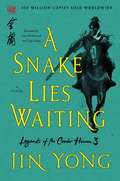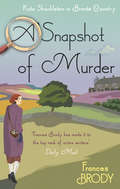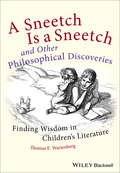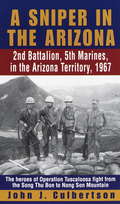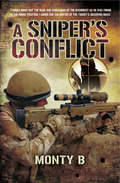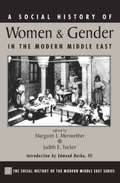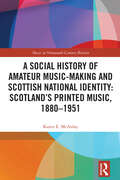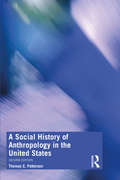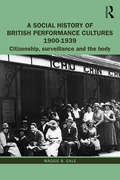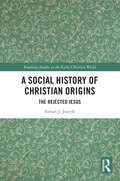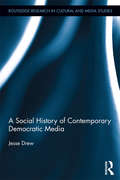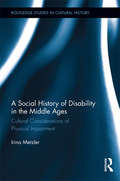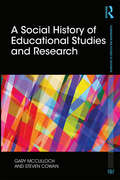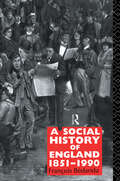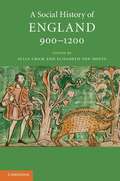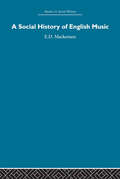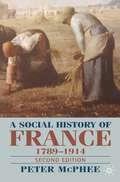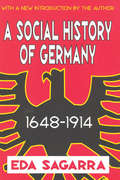- Table View
- List View
A Snake Lies Waiting: Legends of the Condor Heroes Vol. 3 (Legends of the Condor Heroes)
by Jin YongTHE CHINESE "LORD OF THE RINGS" - NOW IN ENGLISH FOR THE FIRST TIME.THE SERIES EVERY CHINESE READER HAS BEEN ENJOYING FOR DECADES - 300 MILLION COPIES SOLD."Jin Yong's work, in the Chinese-speaking world, has a cultural currency roughly equal to that of "Harry Potter" and "Star Wars" combined" Nick Frisch, New Yorker"Like every fairy tale you're ever loved, imbued with jokes and epic grandeur. Prepare to be swept along." Jamie Buxton, Daily MailChina: 1200 A.D.Guo Jing has confronted Apothecary Huang, his sweetheart Lotus' father, on Peach Blossom Island, and bested the villainous Gallant Ouyang in three trials to win her hand in marriage.But now, along with his sworn brother, Zhou Botong of the Quanzhen Sect, and his shifu, Count Seven Hong, Chief of the Beggar Clan, he has walked into a trap. Tricked by Huang into boarding a unseaworthy barge, they will surely drown unless Lotus - who has overheard her father's plans - can find a way to save them.Yet even if they are to survive the voyage, great dangers lie in wait on the mainland. The Jin Prince Wanyan Honglie has gathered a band of unscrupulous warriors to aid him in his search for the lost writings of the Great Song patriot General Yue Fei. If he is successful, the Jin armies will gain the key to total victory over the Song Empire, condemning Guo Jing's countrymen to centuries of servitude.Translated from the Chinese by Anna Holmwood and Gigi Chang(P)2020 Quercus Editions Limited
A Snake Lies Waiting: The Definitive Edition (Legends of the Condor Heroes #3)
by Jin YongA Snake Lies Waiting is the next in Jin Yong's high stakes, tension-filled epic Legends of the Condor Heroes series, where kung fu is magic, kingdoms vie for power and the battle to become the ultimate kung fu master unfolds.Guo Jing has confronted Apothecary Huang, his sweetheart Lotus Huang's father, on Peach Blossom Island, and bested the villainous Gallant Ouyang in the three trials to win the hand of his beloved.But now, along with his two friends and shifus, Zhou Botong of the Quanzhen Sect, and Count Seven Hong, Chief of the Beggar Clan, he has walked into another trap. Tricked into boarding a unseaworthy barge by Apothecary Huang, the three friends will surely drown unless Lotus—who has overheard her father's plans—can find a way to save them.Yet even if they are to survive the voyage, great dangers lie in wait on the mainland. Viper Ouyang, the gallant's uncle and one of the Five Greats of the martial world, is determined to have his revenge on Guo Jing for getting the better of his nephew, and bent on becoming the most powerful master of the wulin. Meanwhile, Yang Kang, who Guo Jing has come to trust, has yet to reveal the full extent of his treachery.
A Snapshot of Murder: A Kate Shackleton Mystery (A Kate Shackleton Mystery)
by Frances BrodyCritically acclaimed author Frances Brody is back with the tenth installment in her Kate Shackleton series, perfect for fans of Jacqueline Winspear and Nicola Upson.Seven keen amateur photographers gather for the most popular openings of the decade. Only six will return.Yorkshire, 1928. Indomitable sleuth Kate Shackleton is taking a well-deserved break from her detective work and indulging in her other passion: photography. When her local Photographic Society proposes an outing to the opening of the Bronte Museum, Kate jumps at the chance to visit the setting of Wuthering Heights. But the setting proves to be even more sinister than the dreary classic when a member of their party is found murdered.The event is one of the most popular of the decade, and each of the seven photographers were there to capture the perfect shot of a lifetime. But Tobias, the deceased, was known for being loud-mouthed and didn’t care to curb his demeanor. Kate deduces that he must have had several enemies. But soon, she begins to suspect that perhaps the murderer is amongst them. And before they shrink to just a group of five, Kate must pick back up her magnifying glass and sleuthing cap to crack the case in A Snapshot of Murder, Frances Brody’s tenth brilliant Kate Shackleton mystery.
A Sneetch is a Sneetch and Other Philosophical Discoveries
by Thomas E. WartenbergTaking Picture Books Seriously: What can we learn about philosophy through children's books?This warm and charming volume casts a spell on adult readers as it unveils the surprisingly profound philosophical wisdom contained in children's picture books, from Dr Seuss's Sneetches to William Steig's Shrek!. With a light touch and good humor, Wartenberg discusses the philosophical ideas in these classic stories, and provides parents with a practical starting point for discussing philosophical issues with their children. Accessible and multi-layered, it answers questions like, Is it okay for adults to deceive kids? What's the difference between saying the Mona Lisa is a great painting and vanilla is your favorite flavor? Each chapter includes illustrations commissioned especially for this book.
A Sniper in the Arizona
by John Culbertson"Morning was always a welcome sight to us. It meant two things. The first was that we were still alive. . . ."In 1967, death was the constant companion of the Marines of Hotel Company, 2/5, as they patrolled the paddy dikes, mud, and mountains of the Arizona Territory southwest of Da Nang. But John Culbertson and most of the rest of Hotel Company were the same lean, fighting Marines who had survived the carnage of Operation Tuscaloosa. Hotel's grunts walked over the enemy, not around him. In graphic terms, John Culbertson describes the daily, dangerous life of a soldier fighting in a country where the enemy was frequently indistinguishable from the allies, fought tenaciously, and thought nothing of using civilians as a shield. Though he was one of the top marksmen in 1st Marine Division Sniper School in Da Nang in March 1967--a class of just eighteen, chosen from the division's twenty thousand Marines--Culbertson knew that against the VC and the NVA, good training and experience could carry you just so far. But his company's mission was to find and engage the enemy, whatever the price. This riveting, bloody first-person account offers a stark testimony to the stuff U.S. Marines are made of.From the Paperback edition.
A Sniper's Conflict: An Elite Sharpshooter's Thrilling Account Of Hunting Insurgents In Afghanistan And Iraq
by Monty B.The Author sets the scene with his early experiences as a sniper during his 2004 Cimic House Al-Amarah tour in Iraq where hard lessons were learnt. Next stop after rigorous training came participation on Op HERRICK 8/9 in Helmand District, Afghanistan.Having already been a Sniper Instructor for eight years by the start of the Helmand Tour, he is well qualified to explain sniping tactics and techniques in fascinating detail. Together with the operational background, his descriptions of many sniper engagements during the Battalion group's eventful and gruelling tour, make this a thrilling and instructive read.Intense though the action was, there were long periods of watching and waiting. Cool nerves are called for; witnessing the taking of life even from distances of a kilometre is traumatic. Snipers work in pairs so relationship and trust are all important.This is a superb action-packed description of professional soldiering at the sharp end. The Author's depth of knowledge and experience make this as good as a sniper's manual.
A Social History Of Women And Gender In The Modern Middle East
by Margaret Lee Meriwether Judith TuckerIn this important new work, Margaret Meriwether and Judith Tucker synthesize and make accessible the results of the extensive research on women and gender done over the last twenty years. Using new theoretical approaches and methodologies as well as nontraditional sources, scholars studying women and gender issues in Middle Eastern societies have made great progress in shedding light on these complex subjects. A Social History of Women and Gender in the Modern Middle East provides an overview of this scholarship on women and gender in the nineteenth- and twentieth-century Middle East.The book is organized along thematic lines that reflect major focuses of research in this area—gender and work, gender and the state, gender and law, gender and religion, and feminist movements—and each chapter is written by a scholar who has done original research on the topic. Although structured around the individual author’s own work, the chapters also include overviews and assessments of other research, highlights of ongoing debates and key issues, and comparisons across regions of the Middle East. An insightful introduction centers the various chapters around key theoretical, methodological, and historical issues and makes connections with other areas of social historical research on the Middle East and with research on gender and women’s history in other parts of the world.Although there are many studies available on women and gender, A Social History of Women and Gender in the Modern Middle East provides a breadth of coverage and assessment of the field that is not found elsewhere.
A Social History Of Women And Gender In The Modern Middle East
by Margaret Lee Meriwether Judith TuckerIn this important new work, Margaret Meriwether and Judith Tucker synthesize and make accessible the results of the extensive research on women and gender done over the last twenty years. Using new theoretical approaches and methodologies as well as nontraditional sources, scholars studying women and gender issues in Middle Eastern societies have made great progress in shedding light on these complex subjects. A Social History of Women and Gender in the Modern Middle East provides an overview of this scholarship on women and gender in the nineteenth- and twentieth-century Middle East.The book is organized along thematic lines that reflect major focuses of research in this area-gender and work, gender and the state, gender and law, gender and religion, and feminist movements-and each chapter is written by a scholar who has done original research on the topic. Although structured around the individual author's own work, the chapters also include overviews and assessments of other research, highlights of ongoing debates and key issues, and comparisons across regions of the Middle East. An insightful introduction centers the various chapters around key theoretical, methodological, and historical issues and makes connections with other areas of social historical research on the Middle East and with research on gender and women's history in other parts of the world.Although there are many studies available on women and gender, A Social History of Women and Gender in the Modern Middle East provides a breadth of coverage and assessment of the field that is not found elsewhere.
A Social History Of Women And Gender In The Modern Middle East
by Margaret Lee Meriwether Judith TuckerIn this important new work, Margaret Meriwether and Judith Tucker synthesize and make accessible the results of the extensive research on women and gender done over the last twenty years. Using new theoretical approaches and methodologies as well as nontraditional sources, scholars studying women and gender issues in Middle Eastern societies have made great progress in shedding light on these complex subjects. A Social History of Women and Gender in the Modern Middle East provides an overview of this scholarship on women and gender in the nineteenth- and twentieth-century Middle East.The book is organized along thematic lines that reflect major focuses of research in this area-gender and work, gender and the state, gender and law, gender and religion, and feminist movements-and each chapter is written by a scholar who has done original research on the topic. Although structured around the individual author's own work, the chapters also include overviews and assessments of other research, highlights of ongoing debates and key issues, and comparisons across regions of the Middle East. An insightful introduction centers the various chapters around key theoretical, methodological, and historical issues and makes connections with other areas of social historical research on the Middle East and with research on gender and women's history in other parts of the world.Although there are many studies available on women and gender, A Social History of Women and Gender in the Modern Middle East provides a breadth of coverage and assessment of the field that is not found elsewhere.
A Social History of Administrative Science in Italy: Planning a State of Happiness from Liberalism to Fascism (Italian and Italian American Studies)
by Andrea RapiniThis book traces the origins, life and death of Administrative Science in Italy as an academic discipline between the nineteenth and twentieth centuries. It does so by combining the study of ideas, institutional history, intellectual history and social history. The Faculty of Law first introduced Administrative Science in 1875, with the aim of providing the elite with the necessary tools to distribute wealth more equally, to take care of the population and, thus, to make the young Italian State more legitimate in the eyes of the emerging masses. Law and social sciences were merged with the aim of increasing reforms, including that of creating a State of Happiness for all citizens. Throughout its 70-year existence, Administrative Science was deprived of its contents and scientific independence, and academically overshadowed by Administrative and Public law. Finally, although the liberal elites discarded the reformer project of Administrative Science even before Fascism turned everything upside down, most of the original traits of this knowledge were absorbed into Fascist corporate and totalitarian structures.
A Social History of Amateur Music-Making and Scottish National Identity: Scotland’s Printed Music, 1880–1951 (Music in Nineteenth-Century Britain)
by Karen E. McAulayLate Victorian Scotland had a flourishing music publishing trade, evidenced by the survival of a plethora of vocal scores and dance tune books; and whether informing us what people actually sang and played at home, danced to, or enjoyed in choirs, or reminding us of the impact of emigration from Britain for both emigrants and their families left behind, examining this neglected repertoire provides an insight into Scottish musical culture and is a valuable addition to the broader social history of Scotland.The decline of the music trade by the mid-twentieth century is attributable to various factors, some external, but others due to the conservative and perhaps somewhat parochial nature of the publishers’ output. What survives bears witness to the importance of domestic and amateur music-making in ordinary lives between 1880 and 1950. Much of the music is now little more than a historical artefact. Nonetheless, Karen E. McAulay shows that the nature of the music, the song and fiddle tune books’ contents, the paratext around the collections, its packaging, marketing and dissemination all document the social history of an era whose everyday music has often been dismissed as not significant or, indeed, properly ‘old’ enough to merit consideration.The book will be valuable for academics as well as folk musicians and those interested in the social and musical history of Scotland and the British Isles.
A Social History of Anthropology in the United States
by Thomas C. PattersonThis book offers a comprehensive introduction to the social history of anthropology in the United States, examining the circumstances that gave rise to the discipline and illuminating the role of anthropology in the modern world. Thomas C. Patterson considers the shifting social and political-economic conditions in which anthropological knowledge has been produced and deployed, the appearance of practices focused on particular regions or groups, the place of anthropology in structures of power, and the role of the educator in forging, perpetuating, and changing representations of past and contemporary peoples. The book addresses the negative reputation that anthropology took on as an offspring of imperialism, and provides fascinating insight into the social history of America. In this second edition, the material has been revised and updated, including a new chapter that covers anthropological theory and practice during the turmoil created by multiple ongoing crises at the beginning of the twenty-first century. This is valuable reading for students and scholars interested in the origins, development, and theory of anthropology.
A Social History of British Performance Cultures 1900-1939: Citizenship, surveillance and the body
by Maggie B. GaleThis book provides a new social history of British performance cultures in the early decades of the twentieth century, where performance across stage and screen was generated by dynamic and transformational industries. Exploring an era book-ended by wars and troubled by social unrest and political uncertainty, A Social History of British Performance Cultures 1900–1939 makes use of the popular material cultures produced by and for the industries – autobiographies, fan magazines and trade journals, as well as archival holdings, popular sketches, plays and performances. Maggie B. Gale looks at how the performance industries operated, circulated their products and self-regulated their professional activities, in a period where enfranchisement, democratization, technological development and legislation shaped the experience of citizenship. Through close examination of material evidence and a theoretical underpinning, this book shows how performance industries reflected and challenged this experience, and explored the ways in which we construct our ‘performance’ as participants in the public realm. Suited not only to scholars and students of British theatre and theatre history, but to general readers as well, A Social History of British Performance Cultures 1900–1939 offers an original intervention into the construction of British theatre and performance histories, offering new readings of the relationship between the material cultures of performance, the social, professional and civic contexts from which they arise, and on which they reflect.
A Social History of Christian Origins: The Rejected Jesus (Routledge Studies in the Early Christian World)
by Simon J. JosephA Social History of Christian Origins explores how the theme of the Jewish rejection of Jesus – embedded in Paul’s letters and the New Testament Gospels – represents the ethnic, social, cultural, and theological conflicts that facilitated the construction of Christian identity. Readers of this book will gain a thorough understanding of how a central theme of early Christianity – the Jewish rejection of Jesus – facilitated the emergence of Christian anti-Judaism as well as the complex and multi-faceted representations of Jesus in the Gospels of the New Testament. This study systematically analyses the theme of social rejection in the Jesus tradition by surveying its historical and chronological development. Employing the social-psychological study of social rejection, social identity theory, and social memory theory, Joseph sheds new light on the inter-relationships between myth, history, and memory in the study of Christian origins and the contemporary (re)construction of the historical Jesus. A Social History of Christian Origins is primarily intended for academic specialists and students in ancient history, biblical studies, New Testament studies, Religious Studies, Classics, as well as the general reader interested in the beginnings of Christianity.
A Social History of Contemporary Democratic Media (Routledge Research in Cultural and Media Studies)
by Jesse DrewThe last few decades have helped dispel the myth that media should remain driven by high-end professionals and market share. This book puts forward the concept of "communications from below" in contrast to the "globalization from above" that characterizes many new developments in international organization and media practices. By examining the social and technological roots that influence current media evolution, Drew allows readers to understand not only the Youtubes and Facebooks of today, but to anticipate the trajectory of the technologies to come. Beginning with a look at the inherent weaknesses of the U.S. broadcasting model of mass media, Drew outlines the early 1960s and 1970s experiments in grassroots media, where artists and activists began to re-engineer electronic technologies to target local communities and underserved audiences. From these local projects emerged national and international communications projects, creating production models, social networks and citizen expectations that would challenge traditional means of electronic media and cultural production. Drew’s perspective puts the social and cultural use of the user at the center, not the particular media form. Thus the structure of the book focuses on the local, the national, and the global desire for communications, regardless of the means.
A Social History of Disability in the Middle Ages: Cultural Considerations of Physical Impairment (Routledge Studies in Cultural History #14)
by Irina MetzlerWhat was it like to be disabled in the Middle Ages? How did people become disabled? Did welfare support exist? This book discusses social and cultural factors affecting the lives of medieval crippled, deaf, mute and blind people, those nowadays collectively called "disabled." Although the word did not exist then, many of the experiences disabled people might have today can already be traced back to medieval social institutions and cultural attitudes. This volume informs our knowledge of the topic by investigating the impact medieval laws had on the social position of disabled people, and conversely, how people might become disabled through judicial actions; ideas of work and how work could both cause disability through industrial accidents but also provide continued ability to earn a living through occupational support networks; the disabling effects of old age and associated physical deteriorations; and the changing nature of attitudes towards welfare provision for the disabled and the ambivalent role of medieval institutions and charity in the support and care of disabled people.
A Social History of Educational Studies and Research: Past, Present – and Future? (Foundations and Futures of Education)
by Steven Cowan Gary McCullochA Social History of Educational Studies and Research examines the development of the study of education in the UK in its broader educational, social and political context since its early beginnings in the first part of the twentieth century. By providing a historical analysis of the contested growth of the field this book examines the significant contribution that has been made by institutions of higher education, journals, text books, conferences, centres, and academic societies. It discusses the problems and opportunities of the field, and its prospects for survival and adaptation to current changes in the decades ahead. The work draws on documentary sources, social network analysis, and interviews with leading figures from across the field. This book highlights international influences on the development of educational studies and research in the UK, its role in the growing internationalisation of the field as a whole, and also comparisons and contrasts with the nature of the field elsewhere. It relates the development to the wider social, political and economic changes affecting higher education in general and educational studies and research in particular. It addresses the historical development of disciplines in higher education institutions and the nature, extent and limitations of interdisciplinarity. A Social History of Educational Studies and Research discuss the problems and opportunities facing the study of education today, and its prospects of adapting to changes in the decades ahead. It is a distinctive and original analysis of educational studies and research that provides the first comprehensive study of its type.
A Social History of England 1851-1990
by Francois BedaridaIn this, the second edition of A Social History of England, Francois Bédarida has added a new final chapter on the last fifteen years. The book now traces the evolution of English society from the height of the British Empire to the dawn of the single European market. Making full use of the Annales school of French historiography, Bédarida takes his inquiry beyond conventional views to penetrate the attitudes, behaviour and psychology of the British people.
A Social History of England, 900–1200
by Julia Crick Elisabeth van van HoutsThe years between 900 and 1200 saw transformative social change in Europe, including the creation of extensive town-dwelling populations and the proliferation of feudalised elites and bureaucratic monarchies. In England these developments were complicated and accelerated by repeated episodes of invasion, migration and changes of regime. In this book, scholars from disciplines including history, archaeology and literature reflect on the major trends which shaped English society in these years of transition and select key themes which encapsulate the period. The authors explore the landscape of England, its mineral wealth, its towns and rural life, the health, behaviour and obligations of its inhabitants, patterns of spiritual and intellectual life and the polyglot nature of its population and culture. What emerges is an insight into the complexity, diversity and richness of this formative period of English history.
A Social History of English Music
by Eric David MackernessFirst published in 2006. Routledge is an imprint of Taylor & Francis, an informa company.
A Social History of English Rugby Union
by Tony CollinsFrom the myth of William Webb Ellis to the glory of the 2003 World Cup win, this book explores the social history of rugby union in England. Ever since Tom Brown’s Schooldays the sport has seen itself as the guardian of traditional English middle-class values. In this fascinating new history, leading rugby historian Tony Collins demonstrates how these values have shaped the English game, from the public schools to mass spectator sport, from strict amateurism to global professionalism. Based on unprecedented access to the official archives of the Rugby Football Union, and drawing on an impressive array of sources from club minutes to personal memoirs and contemporary literature, the book explores in vivid detail the key events, personalities and players that have made English rugby. From an era of rapid growth at the end of the nineteenth century, through the terrible losses suffered during the First World War and the subsequent ‘rush to rugby’ in the public and grammar schools, and into the periods of disorientation and commercialisation in the 1960s through to the present day, the story of English rugby union is also the story of the making of modern England. Like all the very best writers on sport, Tony Collins uses sport as a prism through which to better understand both culture and society. A ground-breaking work of both social history and sport history, A Social History of English Rugby Union tells a fascinating story of sporting endeavour, masculine identity, imperial ideology, social consciousness and the nature of Englishness.
A Social History of France 1780-1914: Second Edition
by Peter McPheeThis volume provides a lively and authoritative synthesis of recent work on the social history of France and is now thoroughly updated to cover the 'long nineteenth century' from 1789-1914. Peter McPhee offers both a readable narrative and a distinctive, coherent argument about this remarkable century and explores key themes such as:- peasant interaction with the environment- the changing experience of work and leisure- the nature of crime and protest- changing demographic patterns and family structures- the religious practices of workers and peasants- the ideology and internal repercussions of colonisation.At the core of this social history is the exercise and experience of 'social relations of power' - not only because in these years there were four periods of protracted upheaval, but also because the history of the workplace, of relations between women and men, adults and children, is all about human interaction.Stimulating and enjoyable to read, this indispensable introduction to nineteenth-century France will help readers to make sense of the often bewildering story of these years, while giving them a better understanding of what it meant to be an inhabitant of France during that turbulent time.
A Social History of France, 1789–1914
by Peter McpheeThis volume provides a lively and authoritative synthesis of recent work on the social history of France and is now thoroughly updated to cover the 'long nineteenth century' from 1789-1914. Peter McPhee offers both a readable narrative and a distinctive, coherent argument about this remarkable century and explores key themes such as: - peasant interaction with the environment - the changing experience of work and leisure - the nature of crime and protest - changing demographic patterns and family structures - the religious practices of workers and peasants - the ideology and internal repercussions of colonisation. At the core of this social history is the exercise and experience of 'social relations of power' - not only because in these years there were four periods of protracted upheaval, but also because the history of the workplace, of relations between women and men, adults and children, is all about human interaction. Stimulating and enjoyable to read, this indispensable introduction to nineteenth-century France will help readers to make sense of the often bewildering story of these years, while giving them a better understanding of what it meant to be an inhabitant of France during that turbulent time.
A Social History of French Catholicism 1789–1914 (Routledge Revivals)
by Ralph GibsonFirst published in 1989, A Social History of French Catholicism 1789–1914 is a clear survey of over a hundred years of Catholicism in French society. It chronicles the religious experience of French men and women, both clergy and laity, in post-revolutionary France. The book begins with a look at Catholic life in the Old Regime and during the French Revolution, and proceeds to topical chapters on the secular clergy, the religious orders, popular religion, religious practice by region, gender and age, and the social classes. The final chapter deals with the re-Christianization of France in the latter part of the nineteenth century. This volume will be of interest to students and researchers of history and religion.
A Social History of Germany, 1648-1914
by Eda SagarraThis volume is a pioneering effort to examine the social, demographic, and economic changes that befell the Jewish communities of Central Europe after the dissolution of the Habsburg Empire. It consists of studies researched and written especially for this volume by historians, sociologists, and economists, all specialists in modern Central European Jewish affairs. The era of national rivalry, economic crises, and political confusion between the two World Wars has been preceded by a pre-World War I epoch of Jewish emancipation and assimilation. During that period, Jewish minorities had been harbored from violent anti-Semitism by the Empire, and they became torchbearers of industrialization and modernization. This common destiny encouraged certain common characteristics in the three major components of the Empire, Austria, Hungary, and the Czech territories, despite the very different origins of the well over one million Jews in those three lands. The disintegration of the Habsburg Empire created three small, economically marginal national states, inimical to each other and at liberty to create their own policies toward Jews in accord with the preferences of their respective ruling classes. Active and openly discriminatory anti-Semitic measures resulted in Austria and Hungary. The only liberal heir country of the Empire was Czechoslovakia, although simmering anti-Semitism and below surface discrimination were widespread in Slovakia. While one might have expected Jewish communities to return to their pre-World War I tendencies to go their independent ways after the introduction of these policies, social and economic patterns which had evolved in the Habsburg era persisted until the Anschluss in Austria, German occupation in Czechoslovakia, and World War II in Hungary. Studies in this volume attest to continuing similarities among the three Jewish communities, testifying to the depth of the Empire's long lasting impact on the behavior of Jews in Central Euro

